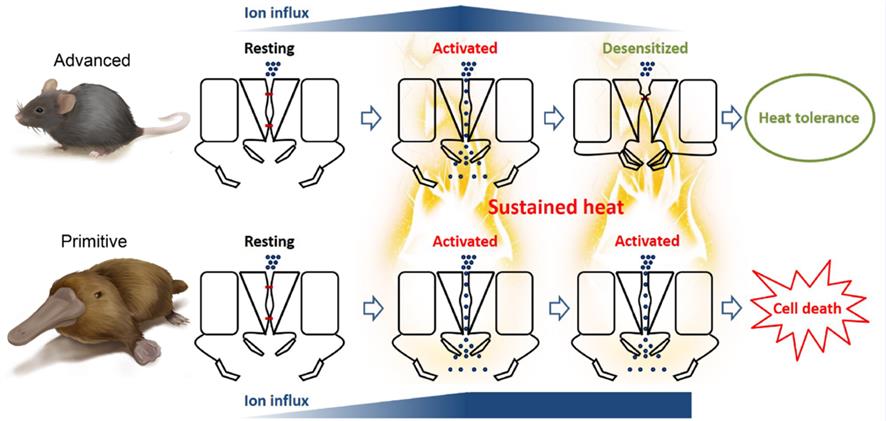TRPV1 is an important temperature sensing element in mammals, which can be activated by high temperatures above 40°C. However, its role in sustained heat response remains poorly understood since a rapid heat-induced desensitization (Dh) process follows a tightly heat-induced activation (Ah) phase, and its function in mammalian biological activities remain elusive. Recently, scientists from Kunming Institute of Zoology, Chinese Academy of Sciences (KIZ, CAS), Zhejiang University and UC Davis reported the molecular basis for Dh of mammalian TRPV1. Furthermore, they showed the biological significance of Dh by using transgenic mice.
To achieve this goal, a TRPV1 that undergoes Ah without Dh was required to be used as a template for research at both the molecular and animal levels. Based on species evolution analysis and functional research, they obtained the platypus TRPV1 (pV1) which undergoes Ah without Dh. By means of chimera construction, fluorescent unnatural amino acid labeling, fluorescence resonance energy transfer and allosteric conformation simulation, they found that the Dh of TRPV1 depends on the interaction between the N- terminal and C- terminal, thus driving the allosteric and closing of the pore region, whereas pV1 does not undergo Dh. To explore the biological significance of TRPV1 Dh, the platypus trpv1 (p-trpv1) transgenic knock-in mice were constructed. Compared to the p-trpv1 mice, wild-type mice are more tolerant to sustained heat stimulation whereas the p-trpv1 mice prefer to keep walking to avoid the stimulation of hot plates.
This study reveals the molecular basis for Dh of TRPV1 channels and its biological significance in mammalian evolution. Moreover, the work shows that TRPV1 Dh is a very important high-temperature protection mechanism for higher mammals. As one of the most primitive mammals, the platypus has yet to evolve a high temperature-mediated "activation-desensitization" equilibrium mechanism. Therefore, the platypus is extremely sensitive to a temperature higher than 25 °C and it is difficult for it to adapt to extreme terrestrial living conditions.
On May 14, 2019, these relevant results were published in Nature Communications under the title "Molecular Basis for Heat Desensitization of TRPV1 Ion Channels" (Nat Commun. 2019, doi: 10.1038/s1467-019-09965-6). Dr. Lei Luo, Dr. Yunfei Wang and Dr. Bowen Li from Kunming Institute of Zoology are the co-first authors. Prof. Ren Lai and Prof. Shilong Yang (from Kunming Institute of Zoology, Chinese Academy of Sciences), Prof. Fan Yang (from Zhejiang University) and Prof. Jie Zheng (from the University of California, Davis) are the co-corresponding authors. The research was supported by the leading project of the Chinese Academy of Sciences, the China-Africa Center of the Chinese Academy of Sciences, the National Natural Science Foundation of China and Yunnan Province.

Molecular basis for heat desensitization of TRPV1 channels and its biological significance in mammalian tolerance to heat. (Image by LAI Ren's Group)
(By YANG Shilong, Editor: HE Linxi)
Contact:
HE Linxi
helinxi@mail.kiz.ac.cn

